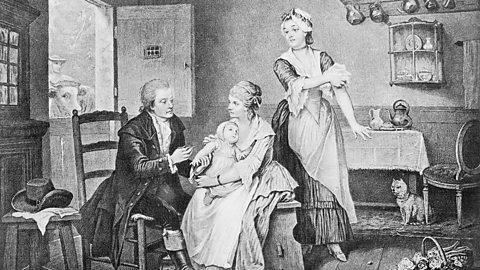Case study - Edward Jenner and vaccination
In 1796 the doctor and scientist Edward Jenner made a discovery that would go on to save thousands of lives. He developed a vaccineA substance that stimulates the body to produce antibodies to provide immunity against a disease. that would prevent people from catching smallpox. Jenner was influenced by the practice of inoculation Putting a low dose of a disease into the body to help it fight against a more serious attack of the disease. which was used in many West African countries as well as the Ottoman EmpireThe Turkish Empire founded at the end of the 13th century. It was one of the most powerful states of the 16th century but collapsed after World War One. This had been witnessed first-hand by Lady Mary Wortley Montagu on her travels in Turkey earlier in the 18th century. She returned to Britain and held smallpox parties, where inoculations would take place.
Smallpox
In the 18th century, smallpox was a deadly disease. It killed more children each year than any other disease and also killed thousands of adults. Those who survived smallpox were left with scars that often left them feeling isolated (left out) in their communities.
Before Jennerãs vaccine, inoculation was being used to prevent smallpox. However, this was a risk, because each person was receiving the real disease into their body. If the dose was too strong, the person could develop smallpox and die.
Jenner and the smallpox vaccine
Edward Jenner was a country doctor in Gloucestershire. He had observed that milkmaids who caught the mild disease cowpox did not go on to catch smallpox. Jenner decided to scientifically test whether cowpox could prevent smallpox. He carried out a series of experiments and recorded his findings.
To test his theory about smallpox, Jenner:
- selected a healthy eight-year-old boy called James Phipps
- took cowpox from a sore on a milkmaidãs hand and inserted it into Phippsã body via two cuts
- observed that Phipps experienced uneasiness, a loss of appetite and a headache as a result of the mild disease but became well again
- Phipps was then inoculated with smallpox, but no disease followed
Jenner repeated his experiment 23 times to prove his theory. In 1798 he published a book describing how to prevent people from catching smallpox by injecting them with cowpox. He called his method vaccination because vacca is the Latin word for ãcowã.

Opposition to vaccination
There was a lot of opposition to the smallpox vaccine:
- Some doctors opposed it because they were making a lot of money from inoculation and didn't want to lose that income.
- The Church did not like the idea of using a disease from cows in human medicine.
The The Royal Society The leading national organisation for the promotion of scientific research in Britain. refused to publish Jennerãs ideas because of this opposition.
Government intervention
The wide use of the smallpox vaccine led to a fall in deaths. In 1852, the government made the vaccine compulsoryRequired by law or rule. After 1872, this was strictly enforced. People were fined for not having their children vaccinated. The result of government involvement was a rapid fall in deaths from smallpox.
In 1980 the World Health OrganisationA part of the United Nations that monitors health throughout the world. announced that smallpox had been completely wiped out.